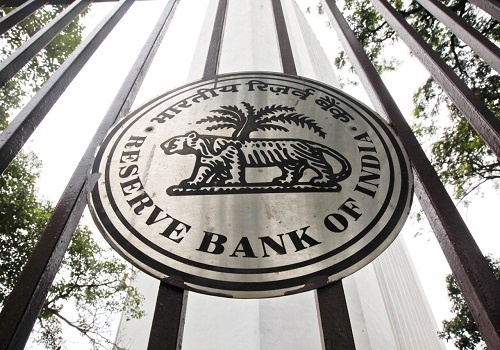Jeera trading range for the day is 40700-44140 - Kedia Advisory

Follow us Now on Telegram ! Get daily 10 - 12 important updates on Business, Finance and Investment. Join our Telegram Channel
https://t.me/InvestmentGuruIndiacom
Download Telegram App before Joining the Channel
GOLD
Gold surged by 1.02%, settling at 60722, driven by alarming weaknesses in the U.S. labor market revealed in the latest employment data. The U.S. Labor Department reported a substantial 13,000 increase in weekly jobless claims to 231,000, surpassing the consensus estimate of 220,000. This unexpected spike, marking the highest unemployment claims since late August, significantly influenced market sentiment. In addition to the labor market concerns, October 2023 witnessed a more-than-anticipated 0.7% decline in U.S. manufacturing production. Industrial production in the U.S. fell 0.6% month-on-month, the highest in four months, exceeding the expected 0.3% decrease. Manufacturing output, constituting 78% of total production, also fell by 0.7%, surpassing the forecasted 0.3% decline. Federal Reserve Chairman Jerome Powell emphasized a commitment to further tightening monetary policy, stating that a failure to control inflation would be the central bank's most significant mistake. Following the release of U.S. inflation data, Thomas Barkin, President of the Richmond Federal Reserve Bank, noted that core inflation was partially offset by supply shortages, adding complexity to the economic scenario. >From a technical standpoint, the gold market is experiencing short covering, evident in the 9.09% drop in open interest, settling at 8609. Despite this, prices rose by a substantial 611 rupees. Gold is currently finding support at 59915, and a breach below this level could lead to a test of 59110. On the upside, resistance is anticipated at 61720, and a move beyond this level might propel prices toward 62720.
Trading Ideas:
* Gold trading range for the day is 59110-62720.
* Gold gains after the latest employment data showed surprisingly elevated weakness in the U.S. labor market.
* Fed has said that it needs to see some weakness in the U.S. labor market before it starts looking at potential rate cuts
* US weekly jobless claims rose by 13,000 to 231,000, up from the previous week's downwardly revised estimate of 218,000 claims
SILVER
Silver experienced a 1.37% uptick, reaching 73360, as global equity markets stabilized amidst dovish Fed sentiments. With a slowdown in headline inflation, investors are watching for signals on the world's largest economy, especially heading into the holiday season. Despite a dip in U.S. retail sales in October, a positive revision in September data indicates consumer resilience. Unexpectedly falling producer prices in the U.S. for October align with easing inflationary pressures, supporting the case for monetary easing by May. The softer stance from central banks boosts silver's appeal in a low-interest-rate environment. However, cautious optimism is warranted as U.S. retail sales, though lower than expected in October, suggests economic resilience. China's robust retail sales and industrial production exceeding estimates hint at increased demand, favoring silver. Moody's downgrade of the U.S. credit rating outlook to negative also bolsters silver's standing. The labor market easing, as indicated by a surge in new unemployment benefit claims, aligns with market sentiment predicting no Fed rate hike in December and growing odds of a cut in the middle of next year. From a technical standpoint, the market witnessed short covering with a 7.86% drop in open interest, settling at 16890. Despite this, silver's price increased by 988 rupees. The support level is identified at 72325, and a breach could test 71285. Resistance is likely at 74080, with a breakthrough potentially leading to a test of 74795.
Trading Ideas:
* Silver trading range for the day is 71285-74795.
* Silver gains as global equity markets steadied after recent strong gains on dovish Fed bets.
* Silver also remained supported by Moody’s downgrade of the US credit rating outlook from stable to negative.
* Data showed amid a surge in Americans filing new unemployment benefit claims suggested a continued easing in the labor market.
CRUDE OIL
The significant drop in crude oil prices by 6.2% to $60.26 per barrel yesterday was primarily driven by a substantial increase in U.S. crude stockpiles and a notable surge in crude production. Concerns over the prolonged weakness in China's property sector also contributed to investor apprehension about potential impacts on fuel demand. Saudi Arabia, the world's largest oil exporter, saw a reversal in trends with a 170,000 barrels per day (bpd) increase in crude oil exports in September, reaching 5.75 million bpd, and a rise in crude production to 8.98 million bpd. However, despite this, Saudi Arabia's crude inventories declined by 4.6 million barrels. Global oil demand remained at a seasonal record high in September, up 2.5 million bpd year-on-year. Conversely, U.S. Energy Information Administration (EIA) data revealed a significant 17.5 million barrel increase in crude stockpiles over the last two weeks, with crude stocks reaching 421.9 million barrels, double the anticipated rise. U.S. crude production also hit a record 13.2 million barrels per day. Technical analysis indicates a bearish market sentiment, with a 9.75% increase in open interest to 4358, coupled with a price decline of -398 rupees. Crudeoil is currently finding support at 5892, and a breach below this level could lead to a test of 5757. On the upside, resistance is anticipated at 6270, and a breakthrough above this level may push prices to test 6513.
Trading Ideas:
* Crudeoil trading range for the day is 5757-6513.
* Crude oil dropped after data showed a sharp increase in U.S. crude stockpiles and a significant jump in crude production.
* Investors also fretted about prolonged weakness in China's property sector and its likely impact on fuel demand.
* Saudi Arabia's crude oil exports rose by 170,000 bpd to 5.75 mbpd in September from 5.58 million bpd in August.
NATURAL GAS
Natural gas prices experienced a significant decline of -5.78% to settle at 254.5 due to a surge in record output, enabling utilities to continue injecting gas into storage until late November. The average gas output in the Lower 48 U.S. states rose to 107.2 billion cubic feet per day (bcfd) in November, surpassing the October record of 104.2 bcfd. However, recent data suggests a potential drop in output to a preliminary one-week low of 106.1 bcfd, aligning with forecasts of warmer-than-normal weather until Nov. 21, followed by a shift to colder conditions from Nov. 22-Dec. 1. With colder weather anticipated, financial firm LSEG predicts an increase in U.S. gas demand in the Lower 48 states, including exports, from 112.2 bcfd this week to 113.8 bcfd next week. This forecast contrasts with Refinitiv's outlook on Wednesday. Gas flows to the seven major U.S. liquefied natural gas (LNG) export plants saw a rise to an average of 14.2 bcfd in November, surpassing the October figure of 13.7 bcfd and the previous monthly record of 14.0 bcfd in April. From a technical standpoint, the market is witnessing fresh selling, with a notable increase in open interest by 66.03% to settle at 35424. Prices experienced a decline of -15.6 rupees. The current support for Natural gas is at 248.2, and a breach below this level could lead to a test of 241.9. On the upside, resistance is likely to be encountered at 266.4, and a move above could result in prices testing 278.3.
Trading Ideas:
* Naturalgas trading range for the day is 241.9-278.3.
* Natural gas eased on record output that should enable utilities to keep injecting gas into storage through at least late November.
* Utilities usually start pulling gas out of storage to meet heating demand in mid-November.
* Average gas output in the Lower 48 U.S. states rose to 107.2 billion cubic feet per day (bcfd) so far in November
COPPER
Copper prices experienced a decline of -0.51% to settle at 708.35, influenced by a strengthening U.S. dollar driven by positive economic data, suggesting a delayed interest rate cut by the Federal Reserve. The dollar gained support from robust retail sales figures and signs of cooling inflation, reinforcing the notion of an economic 'soft landing.' In China, a 14% reduction in inventories at the Shanghai Futures Exchange to under 35,000 tonnes boosted the Yangshan copper premium, indicating a heightened demand for the metal. Slowing prices in the U.S. further fueled expectations that the Fed would refrain from raising rates, exerting downward pressure on the dollar and fostering favorable conditions for manufacturing in economies linked to U.S. credit markets. China's commitment to investing CNY 1 trillion in manufacturing and infrastructure development added to the positive outlook for copper. Reports also suggested a potential injection of CNY 1 trillion by the PBoC into the country's debt-ridden property developers. From a technical perspective, the market saw long liquidation, with a -5.47% drop in open interest to settle at 5050. Copper prices fell by -3.6 rupees. Support is identified at 705.8, and a breach below could lead to a test of 703.2. Resistance is expected at 712.4, and a move above may propel prices to test 716.4.
Trading Ideas:
* Copper trading range for the day is 703.2-716.4.
* Copper prices fell as the U.S. dollar firmed up on economic data
* The dollar drew support from better-than-expected retail sales numbers and more signs of cooling inflation.
* Inventories at the Shanghai Futures Exchange fell by 14% to less than 35,000 tonnes
ZINC
Zinc prices faced a decline of -1.93%, settling at 228.2, attributed to a significant increase in inventories at LME-approved warehouses, rising by 96% to 133,200 metric tons. This surge followed months of dwindling stocks, with a notable inflow of 65,725 tons into facilities in Singapore and Malaysia. LME zinc stocks had previously decreased by 56% since late August. Global zinc market data indicated a surplus of 489,000 tons in the first eight months of the year, compared to a surplus of 156,000 tons during the same period last year, as reported by the International Lead and Zinc Study Group. Glencore, a key commodity trader and miner, plans to take steps in the coming year for a potential restart of its Nordenham zinc smelter, which has been on care and maintenance for over a year. The smelter, located in Germany, is set to resume roasting zinc concentrate in the first quarter of the next year. The decision to restart operations comes amid challenges in the zinc market, particularly related to energy-intensive smelters facing shutdowns and suspensions due to surging power prices after the Russia-Ukraine conflict. From a technical standpoint, the market witnessed long liquidation, marked by a -23.79% drop in open interest to settle at 3739. Zinc prices experienced a decline of -4.5 rupees. The current support for zinc is identified at 226.6, and a breach below could lead to a test of 224.9. Resistance is likely at 230.7, with a potential move above leading to testing at 233.1
Trading Ideas:
* Zinc trading range for the day is 224.9-233.1.
* Zinc prices dropped as LME zinc stocks almost double after big inflows
* Stocks jumped 96% to 133,200 metric tons
* The global zinc market showed a surplus of 489,000 tons during the first eight months of the year
ALUMINIUM
Aluminium prices experienced a decline of -0.87% to settle at 204.3, influenced by a notable increase in aluminum ingot inventories in Wuxi, reaching 223,000 mt, up by 13,000 mt from the previous week. The surge in inventory is attributed to the shift to the off-peak season of downstream consumption, resulting in significant pressure. Social inventories remain at a 6-month high. China's announcement of issuing an additional one trillion yuan of local government bonds aims to stimulate the economy and market. In terms of fundamentals, some aluminum billet factories have reduced production, but the ingot casting volume has increased month-on-month, maintaining a high domestic aluminum supply. Imported ingots continue to enter China, leading to a loose market supply in East China. China's October aluminium production reached a record monthly high, rising 6% from a year ago to 3.62 million metric tons, driven by higher smelter profits and robust domestic demand, especially from the new energy sector. From a technical perspective, the market witnessed long liquidation, with a -1.72% drop in open interest to settle at 2909. Aluminium prices declined by -1.8 rupees. The current support level for aluminium is identified at 203.4, with a potential test of 202.5 below. Resistance is expected at 205.7, and a move above could lead to prices testing 207.1.
Trading Ideas:
* Aluminium trading range for the day is 202.5-207.1.
* Aluminium dropped as the inventory of aluminum ingots in Wuxi was 223,000 mt, an increase of 13,000 mt.
* The inventory pressure is relatively large, mainly due to the shift to off-peak season of downstream consumption.
* China has announced to issue an additional one trillion yuan of local government bonds, which could boost the economy and market.
COTTONCANDY
Cottoncandy prices remained unchanged at 57340, experiencing a standstill due to profit booking after earlier support from factors affecting India's cotton production. Projections indicate a 7.5% decline in India's cotton production to 29.5 million bales in 2023/24 due to lower planted area and the impact of El Nino weather conditions. Import estimates for India have risen to 2.2 million bales from the previous year's 1.25 million bales, according to the Cotton Association of India (CAI). In the U.S., the cotton balance sheet for 2023/24 shows slightly lower consumption but higher production and ending stocks. Higher production in regions outside Texas offsets lower production in the state. Globally, the balance sheet reflects lower consumption but higher production and stocks, with India's 2022/23 production contributing to increased beginning stocks. The final estimate from the Cotton Association of India (CAI) for the 2022-23 season is slightly higher at 31.8 million bales, up from the initial estimate of 34.4 million bales. This contrasts with the government's estimate of 34.3 million bales and the industry's estimate of 29.9 million bales. In north Maharashtra, cotton production is anticipated to decline by 25% due to insufficient rainfall, further impacting the overall production scenario. In the Rajkot spot market, a key market for cotton, prices ended at 26908 Rupees, reflecting a -0.2% decrease. Technically, the market is undergoing long liquidation, with a 1% drop in open interest settling at 99. Despite prices remaining unchanged at 57340, the market's support and resistance levels indicate a potential testing ground. Support is observed at 57340, and a break below could lead to further testing at the same level. Resistance is also identified at 57340, and a move above might lead to prices testing the same level.
Trading Ideas:
* Cottoncandy trading range for the day is 57340-57340.
* Cotton settled flat on profit booking after prices gains as India's cotton production in 2023/24 is likely to fall 7.5%
* Cotton production likely to decline by 25% in north Maha
* USDA cut U.S. production in 2023/24 to 12.8 million bales
* In Rajkot, a major spot market, the price ended at 26908 Rupees dropped by -0.2 percent.
TURMETIC
Turmeric prices saw a decline of -0.77%, settling at 13420, driven by sluggish buying activity in anticipation of stock releases before the new crops arrive in January 2024. Despite this, downside pressure is limited due to potential yield losses from unfavorable weather. Crop conditions are currently favorable, and harvest is expected between January and March. The IMD's projection of drier-than-average October weather may impact crop growth, but sustained buying activity and decreasing supplies are expected to maintain price stability. Export opportunities have improved, with a 25% increase in exports, driven by rising demand in developed and emerging nations. Expectations of a 20–25% decline in turmeric seeding, especially in Maharashtra, Tamil Nadu, Andhra Pradesh, and Telangana, indicate shifting priorities among farmers. Turmeric exports during Apr-Aug 2023 rose by 11.51%, reaching 82,939.35 tonnes, compared to the same period in 2022. However, there was an 18.20% drop in exports in Aug 2023 compared to Jul 2023 and a 6.67% drop compared to Aug 2022. In Nizamabad, a key spot market, turmeric prices ended at 13551.95 Rupees, marking a 0.79% gain. Technically, the market is undergoing long liquidation, with a -0.04% drop in open interest settling at 12600. Despite the price decrease of -104 rupees, turmeric finds support at 13282, and a break below could lead to a test of 13142. Resistance is identified at 13524, and a move above might push prices to test 13626.
Trading Ideas:
* Turmeric trading range for the day is 13142-13626.
* Turmeric dropped in expectation of release of stocks ahead of commencement of new crops
* However downside seen limited due to the potential for yield losses caused by the crop's unfavourable weather.
* Expectations for a 20–25 percent decline in turmeric seeding this year
* In Nizamabad, a major spot market, the price ended at 13551.95 Rupees gained by 0.79 percent.
JEERA
Jeera prices marked a 0.64% increase, settling at 42590, driven by short covering following a recent drop in prices. Adequate soil moisture and favorable weather conditions are expected to boost overall sowing activities, contributing to a normal upcoming jeera sowing season. Stockists are capitalizing on the recent price downfall, triggering short covering. Global demand for Indian jeera has declined as buyers prefer other origins like Syria and Turkey due to higher prices in India. Export seasonality suggests that Indian jeera prices, although competitive globally, might keep overseas demand subdued in the coming weeks. The potential for China to purchase Indian cumin in October-November adds uncertainty to market dynamics. FISS forecasts predict cumin demand exceeding 85 lakh bags this year, with a likely supply of 65 lakh bags. However, jeera exports during Apr-Aug 2023 dropped by 23.76%, totaling 69,779.04 tonnes compared to the same period in 2022. In Aug 2023, jeera exports were 2.61% lower than Jul 2023 and a substantial 66.98% drop compared to Aug 2022. In Unjha, a major spot market, jeera prices ended at 45429.75 Rupees, showing a marginal 0.04% gain. Technically, the market is undergoing short covering, with a -0.95% drop in open interest settling at 4059. Despite prices rising by 270 rupees, jeera finds support at 41650, and a break below could lead to a test of 40700. Resistance is identified at 43370, and a move above might push prices to test 44140.
Trading Ideas:
* Jeera trading range for the day is 40700-44140.
* Jeera gains on short covering after prices dropped as favorable condition for crop will boost the overall sowing activities.
* The upcoming sowing of jeera that is expected to remain normal due to favorable weather condition.
* Stockists are showing interest in buying on recent downfall in prices triggering short covering.
* In Unjha, a major spot market, the price ended at 45429.75 Rupees gained by 0.04 percent.
Views express by all participants are for information & academic purpose only. Kindly read disclaimer before referring below views. Click Here For Disclaimer





















